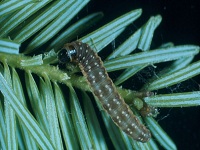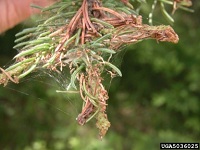Choristoneura fumiferana
Hosts
Colorado spruce, White spruce, Balsam fir and other spruces
Appearance and Life Cycle

In July to early August, every spruce budworm moth deposits about 100 eggs each, in clusters of 15 to 50 on the underside of needles. Within two weeks, larvae emerge and begin to construct overwintering shelters of silk. Larvae do not feed prior to overwintering. Shortly before the buds begin to expand in the spring, the small larvae begin feeding on old needles. As the buds break the larvae move to the new succulent needles and feed for 3 to weeks. Full grown larvae are 20 to 25 millimetres (mm) in length and have a shiny dark-brown head and a reddish-brown body with whitish or yellowish spots. Pupation occurs within the trees, with adults emerging in about 10 days. The budworm has one generation per year.
Damage

Initially, the larvae mine the previous year's needles and cause minimal damage. When the larvae move to the new needles, they form protective shelters by tying the needles and developing shoots together with webbing. Each larva may construct several shelters during their development. Damage is often most noticeable in the crowns of the trees where the foliage appears reddish-brown and scorched. The larvae are wasteful feeders and leave dried, partially consumed needles on the trees. During severe infestations, the budworm can completely defoliate all new foliage along with some old needles. Repeated severe infestations can kill the tops of the trees in 3 years and whole trees in 5 years.
Control
Spruce budworm populations are generally regulated by natural factors and require control only during epidemic outbreaks. Where practical, hand pick the larvae from the tree early in the season. Insecticides registered for budworm control include: Bacillus thuringiensis, dimethoate, malathion and trichlorfon.